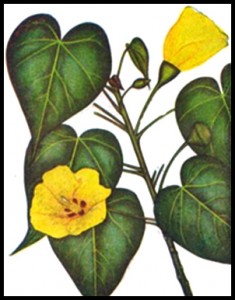
The generic name Thespesia is derived from a Greek word meaning “divine decree”, because it is regarded as a sacred plant, grown in and around sacred places such as churches or temples. The epithet populnea means “of poplars” and indicates the resemblance to the poplar tree.
Distribution
It is commonly found in the Southern states of India, particularly Tamilnadu, Karnataka, Kerala and Andaman. It is also found in Burma, Malaya, Africa and the Pacific Islands. The Portia tree is extensively planted as an avenue tree and grows widely on beaches and tidal forests of the east and west coast.
Description
- It is a large evergreen tree with a crooked stem and attains a height of 30 to 40 feet.
- The leaves are glossy and dark green in colour.
- The flowers are large, bell-shaped, yellowish and deep maroon, resembling the flowers of the cotton plant or ladies finger. The flowering season is during the cold weather.
- The fruits are a capsule, somewhat rounded and flattened at the top.
- The pods are filled with white papery seeds.
- It is a shady tree and is suitable for medium-sized gardens.
Propagation
It is easily raised from seeds or cuttings and its growth is very rapid. It prefers a light porous soil.
Economic value
- The bark yields a strong fibre that is used for making cords and coffee bags.
- The leaves are used for wrapping food.
- The bark and the heartwood yield tannin.
- The flowers and fruits yield a yellow dye
- The wood is used for making gunstocks and cartwheels and in boat building.
- The seeds yield thick deep red-coloured oil known as “huile amere”.
Medicinal Value
- The leaves are applied as a poultice to swellings, sores and abscesses.
- The juice of the fruit is used in external applications to cure cutaneous diseases.
- A decoction of the bark is used as a wash for skin diseases and is also orally consumed as an alternative.
- Regular intake of the juice extracted from the ripened bark cures white patches on the lips due to leucoderma.
- Chronic leprosy can be cured with the root of a 100-year-old tree.
Environmental value
It is tolerant to saline soil and is an excellent avenue tree.
Dr. M. Amirthalingam
C.P.R. Environmental Education Centre
Source: Eco News, Vol.7, No.3 (October – December), 2001.




